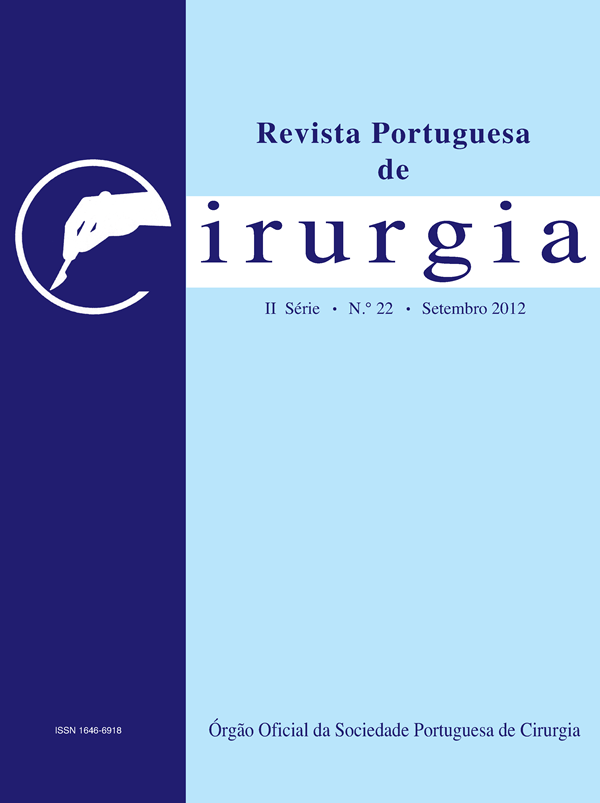Evolution of nutritional status and body composition after major elective surgery
Abstract
Introduction: Despite recognition of its high prevalence and adverse clinical impact, malnutrition remains undervalued and often aggravates during the hospital stay.
Objective: To characterize the progression of nutritional status and body composition in the early postoperative period of major elective surgery and to correlate results with the clinical evolution.
Material and methods: Prospective study including 71 operated patients with evaluation of nutritional status based on anthropometric, laboratorial and functional (hand grip strength) parameters and determination of body composition by bioelectrical impedance analysis, in the day before surgery, in the first and fifth days of the postoperative period and at the moment of hospital discharge.
Results: Patient ́s mean age was 60,4±12,8 (30-91) years, Charlson ́s comorbidity index 3,1±2,8 (0-9) and Surgical Risk Index 8,3±1,14 (6-11). Operative mortality and morbi- dity rates were 7 and 31%, respectively and the mean postoperative hospital stay was 12,4±10,1 (1-61) days. Weight loss referred in the day before surgery was 3,6±7,4% (-12,8-31,1); 1,6% of patients presented a body mass index lower than 20 kg/m2 and 72% an index over 21 kg/m2. Artificial nutritional support was used in 20% of cases. In the postoperative period, a significant deterioration of nutritional and body composition parameters occurred, with a reduction of 1,9% in body weight, 3,4% in tricipital skinfold, 2,6% in mid-arm circumference, 32,2% in pre-albuminemia, 16,8% in transferrinemia, 18,3% in albuminemia, 13,1% in lymphocyte percentage, 12,4% in hand grip strength, 4,3% in body fat mass index and 4,2% in fat-free mass index. Such degradation was pro- portional to the length of postoperative hospital stay, with the exceptions of laboratorial parameters and body fat mass. Mortality was significantly related with greater relative reductions of fat-free mass (20,1 versus 3,7%; p=0,033) and total body water (22,2 versus 2,9%; p=0,013) and morbidity was associated with greater relative reductions of body weight (7,7 versus 1%; p=0,031) and muscular strength (16,8 versus 10%; p=0,014).
Conclusions: Those results seem to corroborate the importance of a systematic surveillance of nutrition status during the perioperative hospital stay and of a timely therapeutic intervention.
Keywords: Nutritional status, body composition, elective surgery, malnutrition
Abbreviations: B.M.I.: body mass index; n.s.: statistically not significant; RR: relative risk; vs: versus; f: Spearman ́s correlation coefficient
Downloads
Downloads
Published
Issue
Section
License
Para permitir ao editor a disseminação do trabalho do(s) autor(es) na sua máxima extensão, o(s) autor(es) deverá(ão) assinar uma Declaração de Cedência dos Direitos de Propriedade (Copyright). O acordo de transferência, (Transfer Agreement), transfere a propriedade do artigo do(s) autor(es) para a Sociedade Portuguesa de Cirurgia.
Se o artigo contiver extractos (incluindo ilustrações) de, ou for baseado no todo ou em parte em outros trabalhos com copyright (incluindo, para evitar dúvidas, material de fontes online ou de intranet), o(s) autor(es) tem(êm) de obter, dos proprietários dos respectivos copyrights, autorização escrita para reprodução desses extractos do(s) artigo(s) em todos os territórios e edições e em todos os meios de expressão e línguas. Todas os formulários de autorização devem ser fornecidos aos editores quando da entrega do artigo.



